Ap Art History the Ancient Near East and Egypt
Unit of measurement 2 Overview
When people inquire AP Art History students about their favorite piece of work 🖼️ in the course, many of them say ones from this unit, and with good reason. The ancient Mediterranean 🌍 is home to some of the almost renowned artworks and historical sites of all time, like the Pyramids of Giza and the Colosseum 🏟️ The people of this area likewise developed new artistic techniques that are used to this twenty-four hours, showing the influence of groups like the Mesopotamians, Greeks, and Romans on art throughout history. So, buckle up because this unit is gonna exist a fun dive into everything ancient Mediterranean!
🚨Reminder 🚨Since these works were made so long ago, we don't know exactly when each was created, so the dates beneath are approximate. Think, you don't need to know the verbal years for all the works on the AP Art History test, just a general idea of when and the artistic motion (or location for earlier ones)!
The Near East (3500 BCE–300 CE) 🇹🇷 🇸🇾 🇮🇶 🇮🇷
In the area surrounding the Tigris and Euphrates Rivers was a fertile river valley called Mesopotamia (nowadays-day Turkey, Syrian arab republic, Iraq, Iran, and small parts of State of kuwait, Saudi Arabia, and Lebanese republic), which was home to the world'due south start civilizations 🏘️This region was composed of city-states, which are cities and surrounding areas that have their own governments and operate equally independent states. Their society was stratified (organized into different social classes) and a monarchy 🤴👸, making Mesopotamia less egalitarian (equal) than the communities mentioned in unit of measurement 1. The people of this region also practiced polytheism, a blazon of religion where followers believe in multiple gods.
These two themes of class and religion are evident in a lot of this region's works, so be certain to await for both of those as we travel around the Near East. Offset end, Sumer!

Epitome Courtesy of Wikipedia (CC BY-SA two.5). Map of the Tigris and Euphrates Rivers and its surrounding areas.
Sumer (3500–2340 BCE)
Architecture
-
More often than not temples and ziggurats (tall towers that were used in religious ceremonies because their pinnacle fabricated them close to the heavens where Sumerian gods reside; believed to connect the Earth 🌍 to the heavens ☁️)
Sculpture
-
Easily folded in gesture of prayer
-
Humans take large, exaggerated eyes 👀, possibly signifying that they are staring at a deity (a polytheistic god or goddess) to a higher place.
-
Men are depicted shirtless while women are dressed modestly, since nudity was associated with depression-status and poverty.
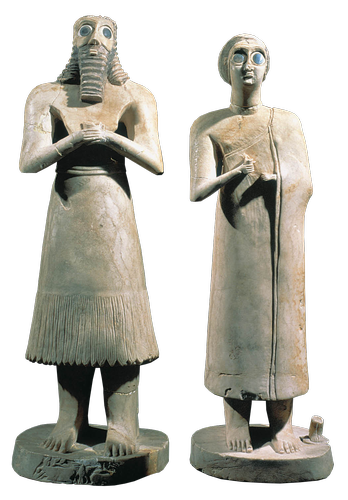
Paradigm Courtesy of Sutori. Statues of Votive Figures.
Babylonia (1792–1750 BCE)
Sculpture
-
Picture both historical (Hammurabi) and mythological figures (Shamash, the Mesopotamian Lord's day god ☀️); shows relationship between humans and the divine
-
Most are bas-relief sculptures (a sculpture that is carved from its medium, AKA a relief sculpture, and barely protrudes from the background).
-
Figures are in the composite view (shoulders are frontal, nevertheless the rest of the trunk is in contour).
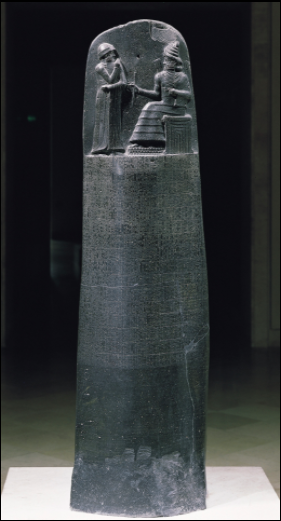
Image Courtesy of Kirby AP Art History on Tumblr. Stele of Hammurabi.
Assyria (883–612 BCE)
Sculpture
-
Human being figures accept a stoic advent 😐, nevertheless animals are depicted with emotion (we'll learn more nigh Stoicism and stoic art when we get to Greece).
-
Artists like to combine both man and animal figures, as seen in the lamassu (human-headed balderdash or lion 🦁 in Assyrian mythology) beneath.
-
Were used for apotropaic purposes (to ward off harm and bad luck)
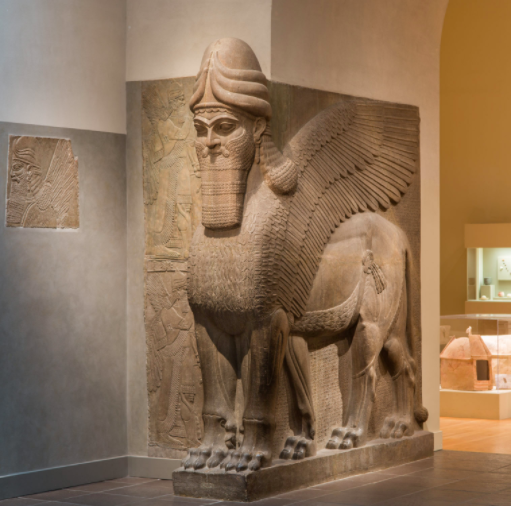
Image Courtesy of AP Art History Become! Lamassu.
Persia (559-331 BCE)
Architecture
-
Meant to impress Persia'south residents and visitors and bear witness off the wealth of its rulers to others 👑
-
Persepolitan columns (columns with ii carved bulls for capitals) are commonly seen in Persian architectural works.
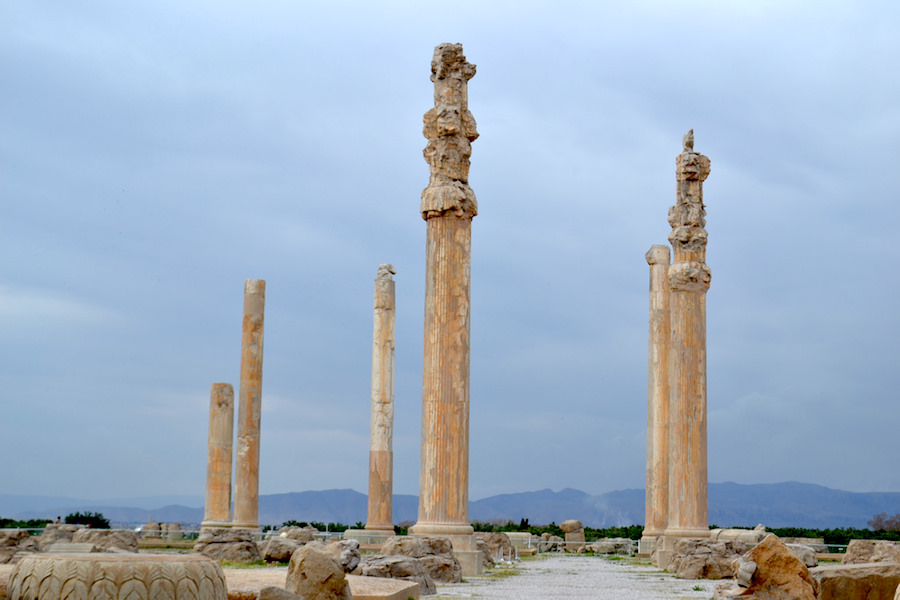
Image Courtesy of Alan Cordova on Flickr (CC By-NC-ND two.0). Persepolis.
Egypt (3000–30 BCE) 🇪🇬
Compages
-
Pyramids are built every bit a office of a greater complex called a necropolis (an area used for burials) ⚰️
-
Egyptian architecture has become grander and more than elaborate over time; architects opted for pyramids over mastabas (unassuming tombs found in the ground), and engaged columns (columns that are fastened to a wall, rather than freestanding) get popular.
-
New architectural elements: the hypostyle hall (hall with a roof supported by columns) and clerestory (a roof that is college than other roofs in a edifice 🏛️).
-
Columns fabricated during the time of the New Kingdom (1550-1070 BCE) accept lotus, palm 🌴, or papyrus-shaped capitals (upper part of a column).

Epitome Courtesy of Amy Calvert. Pyramid of Khafre.
Painting
-
Hieroglyphics (aboriginal Egyptian writing arrangement ✏️ that uses symbols to represent characters) beautify many works and provide more than context nigh their purpose, who is pictured, and what they achieved during their lives
-
Created to ensure that the deceased 💀 would make information technology to the afterlife
-
Painted on papyrus (a paper-like writing surface fabricated from the papyrus plant)
-
Canon of proportions: shoulders are frontal, the balance of the trunk is in profile (shown from one side), men are depicted tallest while women and children are shorter
-
Lack of shading gives figures a flat, unrealistic appearance
-
Figures are commonly pictured forth a basis line (primary line where the figures are continuing), but some are pictured on registers (other horizontal lines) about the meridian of the work to mimic the appearance of distance (as seen below ⬇️)
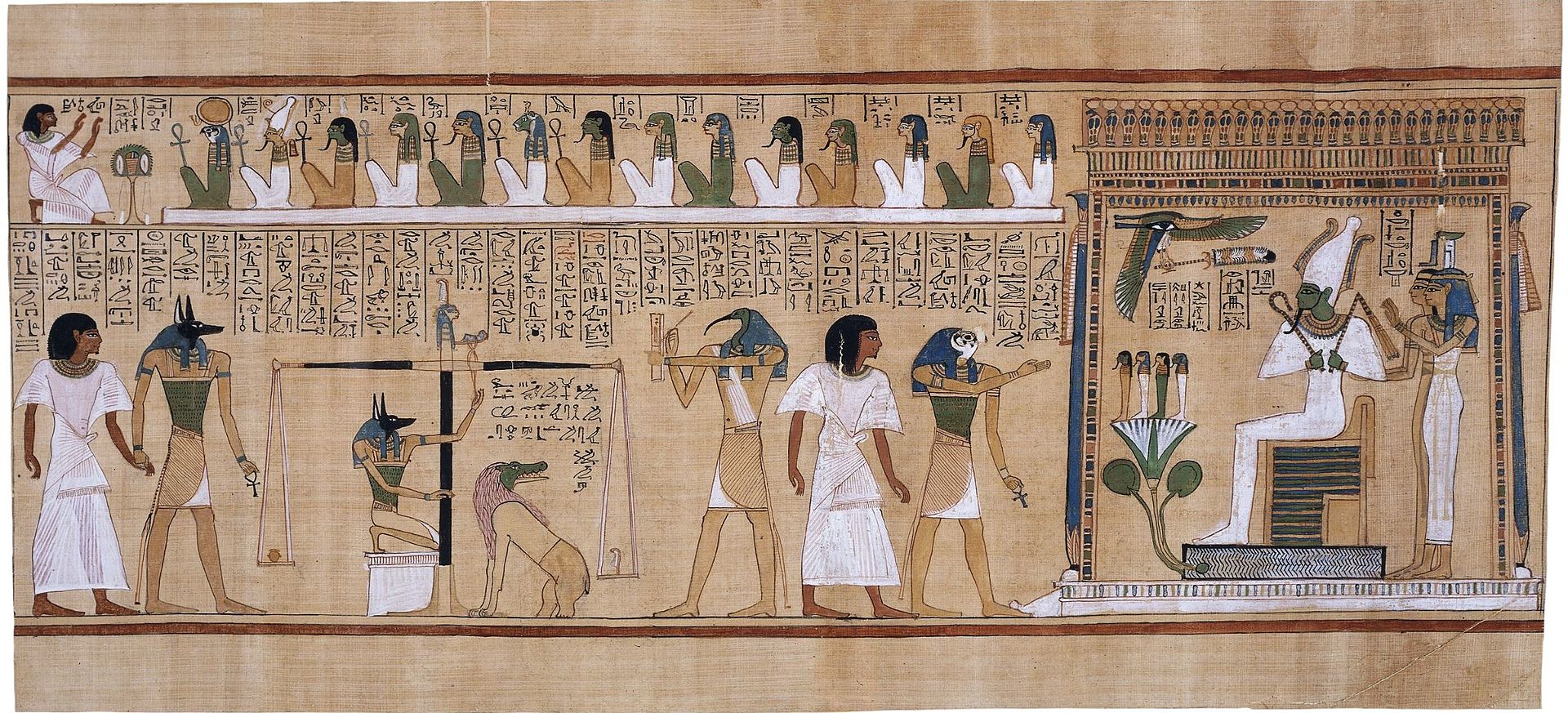
Image Courtesy of Wikipedia. Concluding Judgment of Hu-Nefer.
Sculpture
-
Ordinarily carved from rock, rather than cut free from information technology
-
During the Amarna Period (1346-1336 BCE), artists began to suspension the canon of proportions and depicted humans with protruding stomachs, softer limbs, and more realistic-looking bodies (as seen below ⬇️)
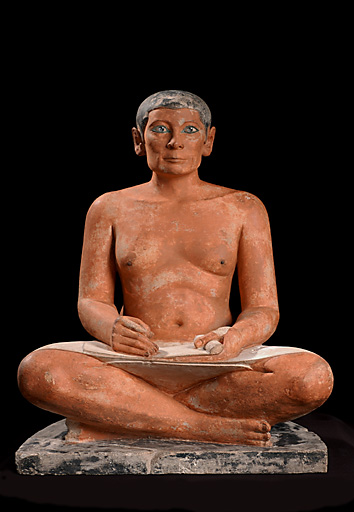
Image Courtesy of the Musée du Louvre. Seated Scribe.
Source: https://library.fiveable.me/ap-art-history/unit-2/unit-2-intro-east-3500-bce%E2%80%93300-ce/study-guide/1GHHDAbY6gK3IXBEM9IO
0 Response to "Ap Art History the Ancient Near East and Egypt"
Post a Comment